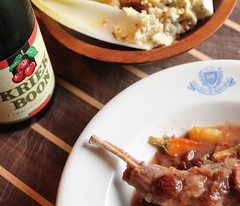Belgian Connection 1: Lapin à la Kriek
There were many great meals that we prepared at home over the course of 2012, and, yes, quite a few of them involved green chiles of one variety or another, but perhaps my favourite was one of the most unexpected. Unexpected not because the dish was new to us, or because the recipe was particularly challenging, or because things appeared to go poorly, but somehow turned out well. In this case, it was unexpected because another dinner party, one that we'd been invited to, had fallen through, and we'd decided not only to host the same guest list at our place, we'd also decided to use the principal ingredient that was meant to be the focus of that other party: rabbit. So there wasn't a whole lot of time for planning, but, more importantly, we had to figure out what we were going to do with all this rabbit, a meat we hadn't had a lot of experience with.
Luckily, I'd given a fair bit of thought to hosting a dinner party involving rabbit over the last couple of years. I'd come back from one of my many trips to Belgium with quite a few bottles of quality kriek, and I knew exactly what I wanted to do with them: make a traditional Belgian specialty named lapin à la kriek.
Kriek (pronounced "creek") has a bit of a funny reputation. Of course, to the Germans, the whole idea of producing beer with fruit is simply horrifying, and it's one of the characteristics that they see as sullying Belgium's much-vauted beer-making reputation (just don't question Franz about the bananenweizen he's drinking). But even within Belgium, kriek is seen by many as being a "little old lady's beer," because so many modern-day krieks are both weak and cloyingly sweet, bearing little resemblance to the tart, refreshing cherry lambics of the past. I'd returned with a supply of Boon kriek, one of the few brands that's widely available in Belgium and still made in the traditional manner--in this case, with black cherries added to a six-month old lambic for a second fermentation.
 fig. a: kriek chez Cantillon
fig. a: kriek chez Cantillon
Anyway, I'd fallen in love with good kriek (especially Boon and Cantillon brands, but Waterbury Vermont's dearly departed The Alchemist also made a lovely one) and I wanted to throw a party that showcased this misunderstood, even maligned, classic, and no dish does a better job than lapin à la kriek.
A couple of other reasons the results here were unexpected: 1) The rabbits had been brined. Like I said, the original intention had been to make some other dish with them, and, consequently, the rabbits had been brined for a couple of days. Lapin à la kriek involves marinating the meat in the beer, and we weren't sure if those brined rabbits would still take on the delicate flavours of the kriek, but they did. 2) We started the dish relatively last-minute. Most recipes call for the meat to be marinated overnight, or for at least 8-12 hours. We only picked up our rabbits at around noon and we served dinner at around 8:00 pm, so, realistically, our meat had only marinated for about 4-5 hours. You might think the rabbit wouldn't have had the chance to pick up the delicate flavours of the kriek, but you'd be wrong.
One reason this dish turned out so well: We held a trump card. We had some of Michelle's preserved sour cherries on hand, and that's what we used to give the dish the cherry boost it calls for. When seeking out cherries for your own cherry boost, look for either frozen or preserved sour cherries, assuming you don't preserve your own. You want cherries that are tart and only lightly sweet. You can find sour cherries at your better Middle Eastern and Eastern European specialty food stores.
We decided to save our Boon krieks for drinking and to cook instead with one of the only krieks available in Quebec, Mort Subite brand, made by the people at De Keersmaeker. Mort Subite is a decent kriek--it's certainly good enough to cook with--but it's not a traditional kriek and it's quite a bit sweeter and less interesting than Boon's. Kriek was what we had as our apéro, and it went exceptionally well with the assortment of charcuterie that we served. By the time it came to digging into the lapin à la kriek, however, we'd moved on to white wine, and the wine flowed freely. No one else at the table had experienced this dish before, and a good batch of lapin à la kriek can be quite a revelation, bestowing Belgian cuisine and its beer-making tradition with the love it deserves. We must have been toasting that rabbit like crazy--somehow we went through an usually high number of bottles that night.
 fig. b: lapin à la kriek
fig. b: lapin à la kriek
Sauté the shallots in the same skillet until soft and just beginning to caramelize. Add the carrots and sauté for 5 minutes. Add the thyme sprigs, the reserved kriek, the rabbit pieces, and dry white wine as needed. Simmer gently with the lid off to reduce for about 30-45 minutes. Check the rabbit for doneness. When the rabbit is fully cooked and perfectly succulent, place the pieces in your serving dishes.
Add the cherries and the red currant jelly. Simmer for another five minutes, adjusting the seasoning. Dress the rabbit with the sauce, making sure to be generous with the sour cherries.
Serve with roasted potatoes, a nice salad, a loaf of crusty bread, and some quality bottles of kriek and/or white wine (we did both).
Serves six generously.
aj









No comments:
Post a Comment